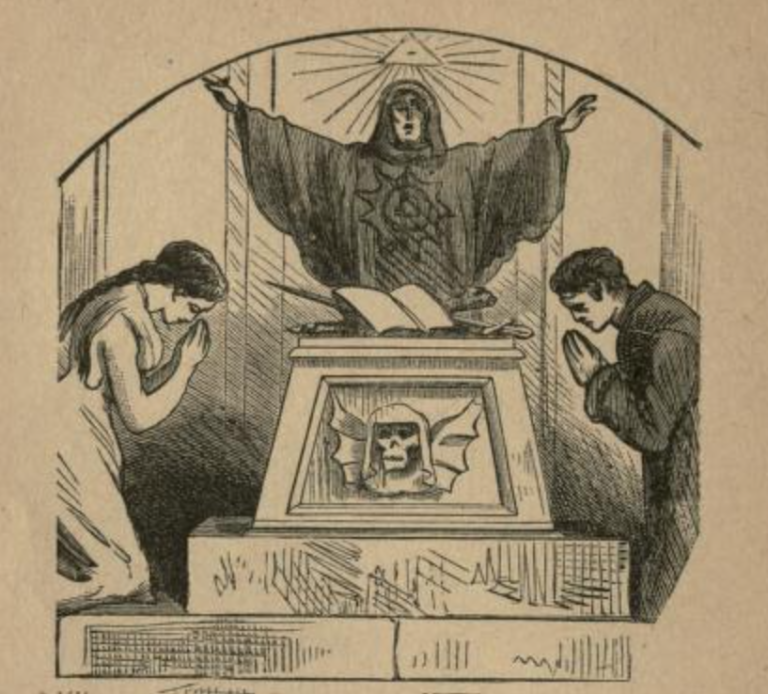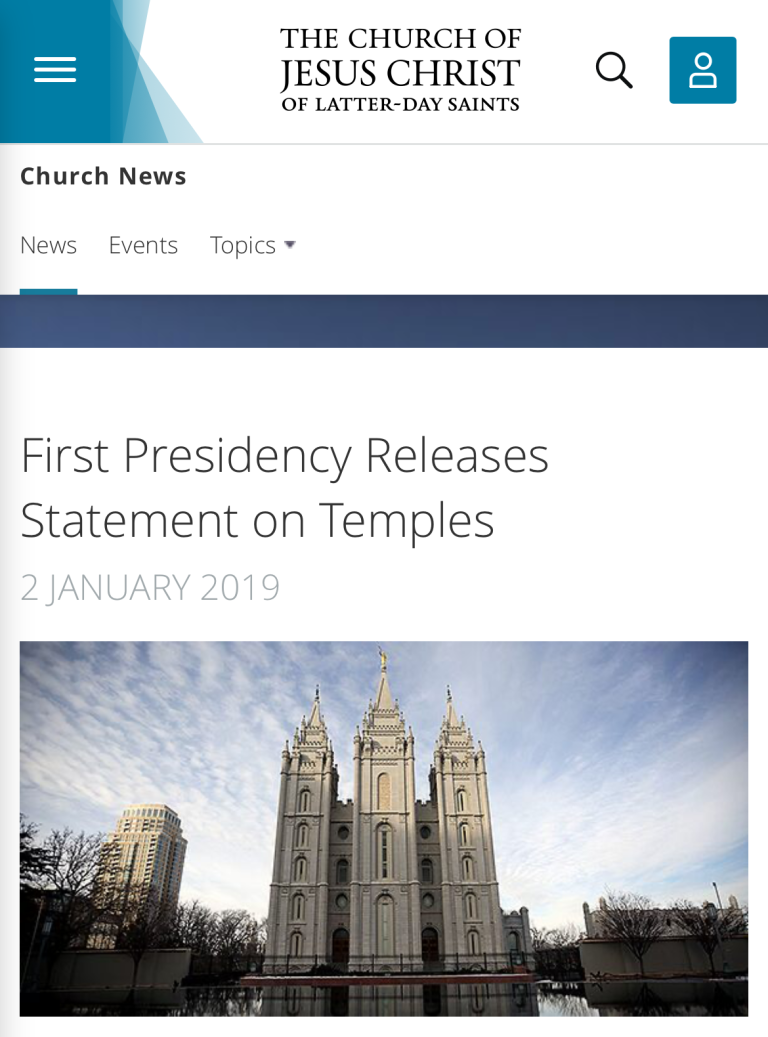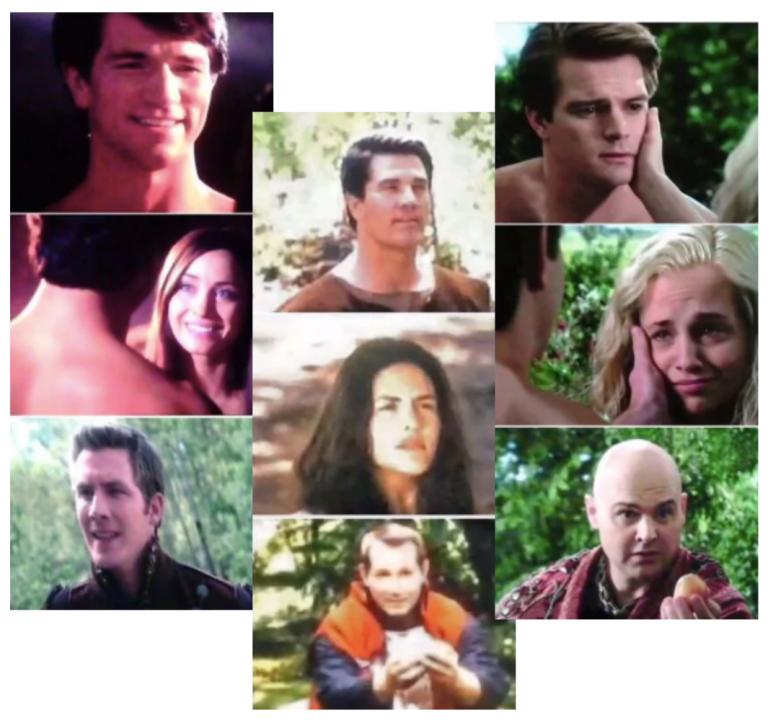Endowment
in the Mormon Temple
"It is claimed that the mysterious rites were taken from Masonry, and that the Endowments are a direct outgrowth of the secret society. Brigham Young delights, I know, to speak of it
as "Celestial Masonry," but I am very sure all good Masons would repudiate it
and its teachings."
-Ann Eliza Webb Young

The Endowment
The Endowment is a performance or a drama (now projected onto a screen) of the story of the earth’s creation, the fall of Adam and Eve, and their sojourn in the "lone and dreary world." During this ceremony, temple patrons are given certain signs and tokens and, until recently, penalties.
The Cast
of the Endowment Ceremony
Today, the cast/film consists of the following characters:
- Elohim (Heavenly Father)
- Jehovah/Jesus
- Michael/Adam
- Peter
- James
- John
- Eve
- Lucifer
Preacher
Before 1990
Previously, the cast/film had an additional character:
- Preacher
- Elohim (Heavenly Father)
- Jehovah/Jesus
- Michael/Adam
- Peter
- James
- John
- Eve
- Lucifer


Five Preachers
Mid-Late 1800s
Actually, previous to the Protestant Preacher character, there were actually FIVE preachers:
- Timothy Broadbrim, a Quaker
- Deacon Smith, a Methodist
- Parson Peabody, a Presbyterian
- Elder Smooth-Tongue, a Baptist
- Father Boniface, a Catholic
Also, interestingly, Jehovah and Jesus were played by two different people.
[Wife No. 19 by Ann Eliza Young, pg. 357]
Ann Eliza Webb shares her experience as follows: “We were waited upon by representatives of the different sects, each descanting upon his peculiar plan of salvation, and its advantage over all the rest. The Quaker advocated his non-resistance doctrine. The Methodist gave a graphic, but not very refined description of the future torments of those who did not take his road to heaven. The Presbyterian gave his belief in foreordination and election in the very terse lines, —" You can if you can't ; If you will you won't ; You'll be damned if you do ; You'll be damned if you don't." The Baptist expatiated upon the virtues of immersion and close communion, and insisted upon predestination as the principal basis of religion; the Catholic called for observances of fasts and prayers to the Virgin Mary."
Peter, James, and John
December 13, 1845
During the earliest Endowment ceremonies Peter, James and John were not characters in the drama/play. They first appeared in the temple Endowment on December 13, 1845 in Heber C. Kimball's journal. None of the other entries in his journal reference Peter, James, or John and in the first expose of the temple that was published in the Warsaw Signal in 1846, there is also no mention of Peter, James, and John. A man named Increase McGee Van Deusen's account published the following year, likewise, says nothing about Peter, James and John. In Fanny Stenhouse's book Tell It All, published in 1875, Peter, James, and John are referenced.

On December 13, 1845, Heber C. Kimball's journal reads:
At 20 minutes after 12 commenced receiving the above through the ceremonies[;] the officers officiating were as follows,
President B. Young as Eloheem
John Taylor as Yehovah
H. C. Kimball as Michael
W. W. Phelps as the Serpent
P. P. Pratt as Peter
Amasa Lyman as James
Orson Pratt as John
Last evening an arrangement was made establishing better order in conducting the endowment. Under this order of province of Eloheem, Yehovah and Michael to create the world, plant the Garden and thrusts them into the telestial kingdom or the world. Then Peter assisted by James and John conduct them through the Telestial and Terrestrial Kingdoms administering the charges and tokens in each and conduct them to the veil where they are received by the [?] Eloheem and after talking with him by words and tokens are admitted by him into the Celestial Kingdom.

Adam and Eve
Mid/Late 1800s
During the earliest recitations of the Temple Endowment, temple patrons each acted as Adam and Eve. This later changed to having a single Adam and a single Eve.
Drama/Film
of the Endowment Ceremony
The temple film has three basic parts:
- The Creation - in which Elohim instructs Jehovah and Michael through the six creative days
- The birth of Adam and Eve. Lucifer appears in the Garden of Eden and temps them to partake of the fruit which they do and are cast out.
- Adam and Eve are with Lucifer in the Lone and Dreary World when Peter, James, and John appear and give them further instructions including signs and tokens.
Slideshow with Christ
Present day
Today the drama/film is a slideshow presentation that is projected onto a wall. Many of the slides are paintings of Jesus (many never before seen). As the drama continues, slides of Elohim, Jehovah and Michael fill the screen and later of Adam and Eve, and Peter, James, and John as the story unfolds. Lucifer is the villain of the drama.
Before 2023, the slideshow presentation did not depict separate images of Christ. Jehovah/Jesus was only on the screen when he was speaking.


Slideshow of the film
2019-2023
In 2019, the church unexpectedly made the decisions to change the temple film into a slideshow presentation.
It is believed that the previous films were directed by a man named Sterling Van Wagenen who was arrested in 2019. He was convicted of child sexual abuse and sentenced to six years to life in prison. This could very well be the reason the films were changed to a single slideshow presentation.
The new slideshow presentation is much shorter than the films. I was taught that the reason for the change was so that more people could go through the temple. The run time was now around 1 ½ hours.
Church's response
to 2019 changes
“Whenever the Lord has had a people on the earth who will obey His word, they have been commanded to build temples. Scriptures document patterns of temple worship from the times of Adam and Eve, Moses, Solomon, Nephi, and others.
With the restoration of the gospel in these latter days, temple worship has also been restored to bless the lives of people across the world and on the other side of the veil as well.
Over these many centuries, details associated with temple work have been adjusted periodically, including language, methods of construction, communication, and record-keeping. Prophets have taught that there will be no end to such adjustments as directed by the Lord to His servants.
A dedicated temple is the most holy of any place of worship on the earth. Its ordinances are sacred and are not discussed outside a holy temple.”


Three new films
2013
In 2013, the Church released three new temple films that played in nearly every temple.
Older films
Before 2013
Before 2013, the Church used two different films representing the drama.


Fruit tied to tree
Mid/Late 1800s
During the 1800s each of the patrons acted as Adam or Eve and they each partook from the Tree of Knowledge which was a small evergreen tree with a type of fruit tied to it (apples, oranges, grapes, or raisins). During this part of the ceremony, plated pots and boxes were brought in to set the backdrop for the Garden of Eden.
Satan in black costume
1800s
The character of Lucifer would come out and tempt Eve to partake of the fruit. Lucifer was always a white man dressed in black clothes (sometimes with a black face).
Ann Eliza Webb tells us that: “..While [Adam] was away, Satan entered and commenced a desperate flirtation with the coy and guileless Eve. The Garden of Eden is represented by painted scenery and furnishings.”
“Satan was dressed in a tight-fitting suit of black, slashed with pink, pointed shoes, helmet, and a hideous mask. His costume, with the exception of the mask, resembled very closely the dress always worn by the stage Mephistopheles. I think he must have had different costumes, since it has been described several times, and the descriptions have varied in every case.”


Hide & Seek
Mid-Late 1800s
Ann Eliza gives a fun recitation of her experience in the temple:
“After the aprons were on [after Adam and Eve partook of the fruit and discovered their nakedness], the voice of Elohim was heard calling Adam; but he was afraid, and hid himself with Eve. All the rest of us were supposed to follow their example, and there was a most undignified scurrying behind sofas, chairs, or any other article of furniture that was convenient. It was like nothing so much as the old game of "hide-and-seek," and it was a rare piece of fun to see men and women scudding in every direction about the room. It was like a good old-fashioned frolic to me, and I actually laughed aloud, much to my discomfiture and Heber Kimball's horror, who reproved me afterwards, and told me it was ver}'" wrong. "For," said he, "these things are sacred, and make me feel as solemn as the grave, and I can scarce refrain from shedding tears every time I see them."
Drinks with the Devil
Part of the early temple ceremony in the 1800s was having drinks with the Devil.

The Devil as a snake
Mid/Late 1800s
“The devil was then cursed, and he fell upon his hands and knees, and wriggled and hissed in as snake-like a manner as possible; we were all brought out from our several hiding-places, the curse was pronounced upon us, which doomed us to leave the beautiful garden, and earn our bread by the sweat of our brows. We were then driven into another room, which was called the world; and then we had taken our "First Degree."
Signs, Tokens, & Penalties
of the Endowment Ceremony

Arm to the square,
palm forward,
thumb extended
Present day
Today there are signs and tokens that are given and shown in the temple ceremony. The temple patrons are instructed at different points in the ceremony to hold their right arm (at one point the left arm) to the square and at other times holding the other arm down with the fingers close together with the thumb extended, or in cupping position.
These signs are not explained at any point during the ceremony.
Hand across throat, stomach & heart
1990
Before 1990, the penalties were much different. Instead of holding their right arm to the square, the patrons would take their hand and slide it across their throat. Additionally, when the hand was next to them facing down (as depicted) they would slide their hand across their stomach.
These signs are not explained at any point during the ceremony.
The Patrons are told that they make these covenants "at the peril of your own life."


Violent rhetoric
1800s
Ann Eliza Webb explained that: “The breaking of this latter oath was to be followed by the most horrible penalties; torture of the most excruciating kind was to be inflicted upon anyone who should disregard this oath — his bowels should be torn from him while he was yet alive; his throat should then be cut from ear to ear; his heart and his tongue cut out; and in the world to come he should inherit eternal damnation. There should be, nor could be, no chance of salvation for him.
"These promised penalties are by no means mere forms of words, given merely to add impressiveness to the ceremony. The "Blood-Atonement" shows that they are carried out, and hundreds of cases could be cited in addition to those already given, to prove that the Endowment-House penalties are by no means dead letters in the Mormon Church law. The cutting of every Gentile and apostate throat, and the " sending to hell across lots," that have been so openly and emphatically urged from the stand by Brigham Young and others, is only a public expression of the mysteries of the Endowment oaths.”
All of these penalties have their roots in Masonry.
Five Points of Fellowship
Before 1990
The five points of fellowship was an important “embrace” between the temple patron and “the Lord”. The five points of fellowship was a vital part of the temple ceremony upon which the final sign was given before entering God’s presence.
“The five points of fellowship are: inside of right foot by the side of right foot, knee to knee, breast to breast, ahnd to back, and mouth to ear.”
It was removed from the temple ceremony in 1990 (after 144 years) without any explanation.
